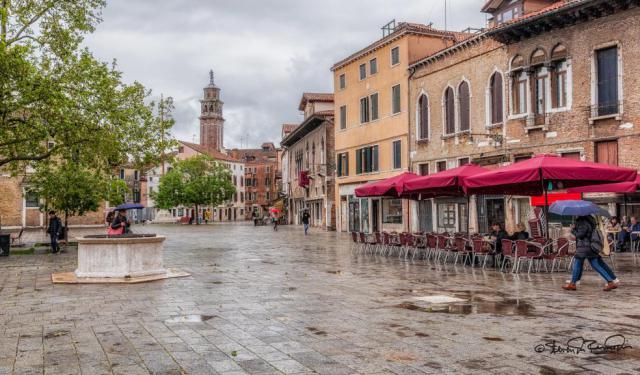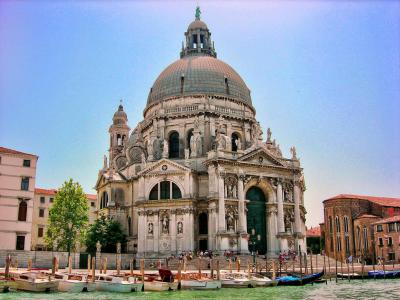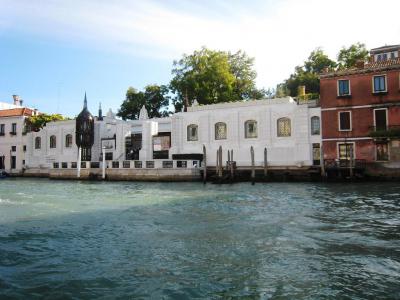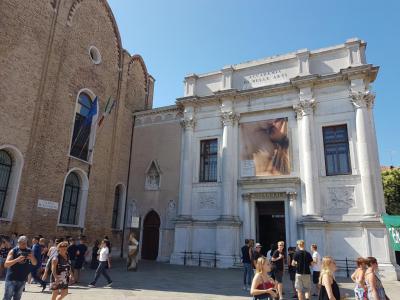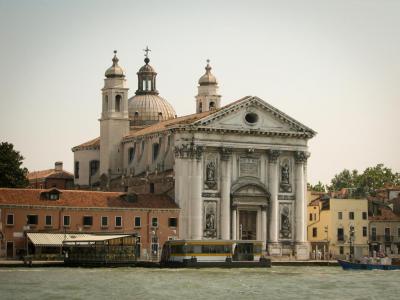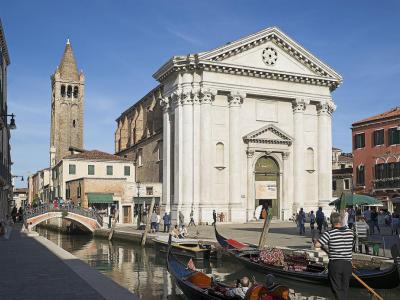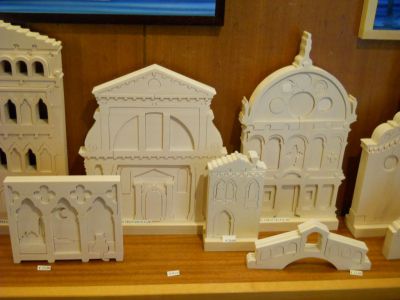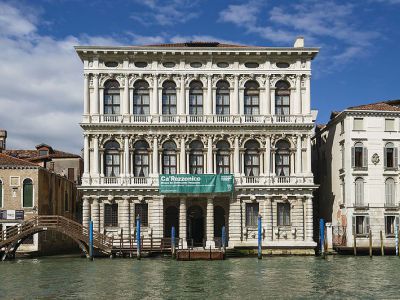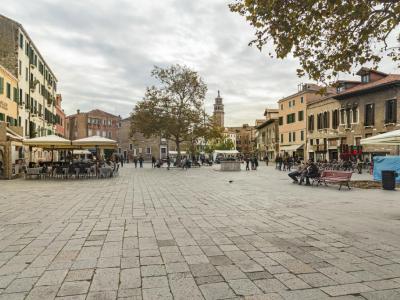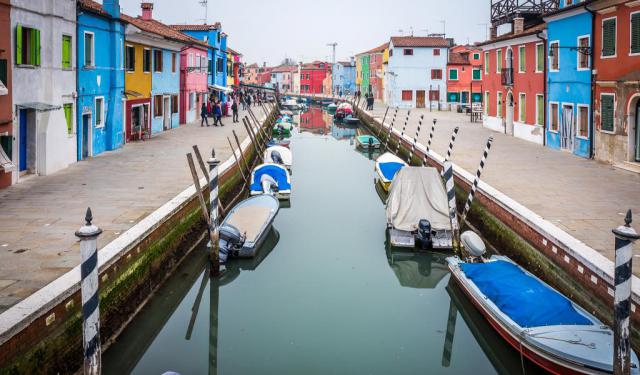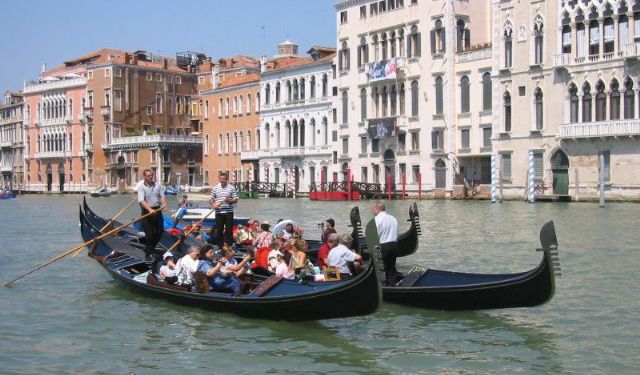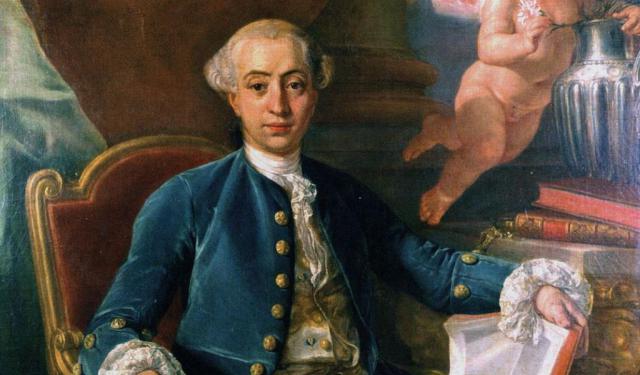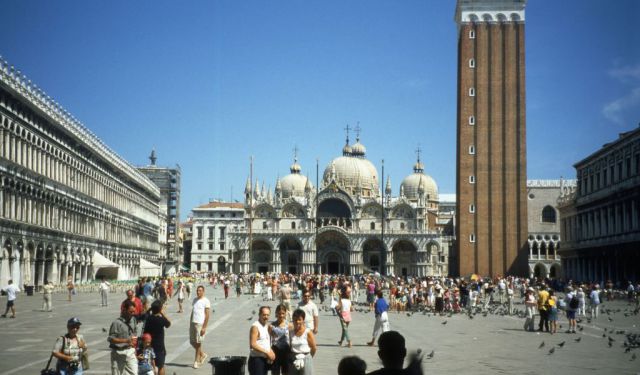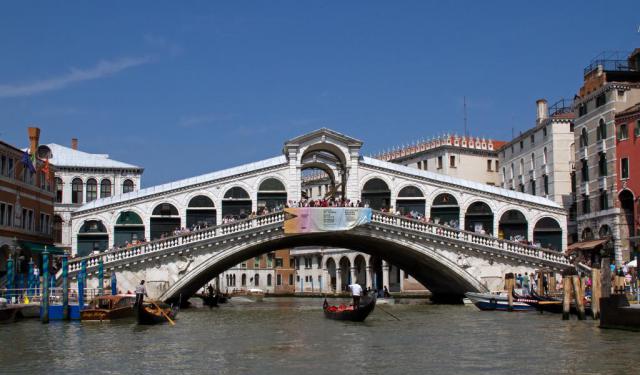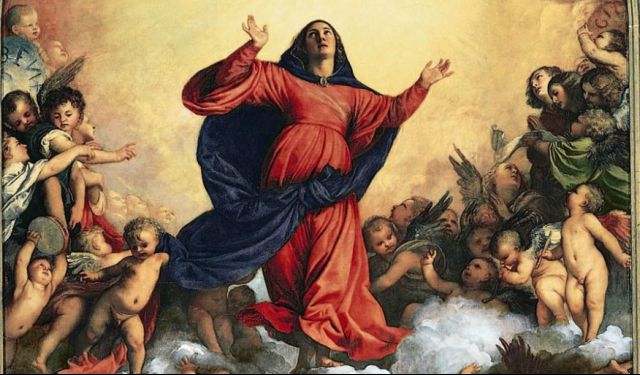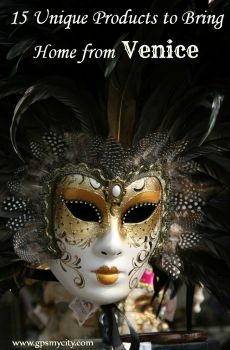Dorsoduro Walking Tour (Self Guided), Venice
One of the six districts of Venice, Dorsoduro’s name translates as “hard bridge” due to the area's relatively high terrain. Home to some of the city’s highest spots, it also comprises some of Venice’s most picturesque canals, historic locations and cultural venues, including the Basilica di Santa Maria della Salute; the Gallerie dell’ Academia & the Ca’ Rezzonico – both jam-packed with fabulous frescos and paintings; and, for those with more modern sensibilities, the Peggy Guggenheim Collection.
One of the great things about the church of Santa Maria del Rosario is that the works of some of the great Venetian masters are in their rightful place rather than in an art museum. These include ceiling frescoes by Tiepolo and wall paintings by Tintoretto, Piazzetta and – last but not least – Sebastiano Ricci, considered the most important painter active in Veneto between the 17th and 18th centuries.
There are many squares here, too – both large and small – to choose from. Because of an appearance in “Indiana Jones and the Last Crusade”, Campo San Barnaba is a favorite destination; however, its other big draws are an unusual canal barge selling fabulous fresh vegetables and fruit, as well as Signor Blum’s corner shop packed with colorful, eye-catching, one-of-a-kind items. Meanwhile, Campo Santa Margherita, is one of the city's liveliest places, with numerous outdoor cafés/restaurants, excellent ice-cream shops and fish and flower stalls.
If modern art, historic architecture and peaceful surroundings combined sounds like your kind of fun, this self-guided walking tour of Dorsoduro is for you.
Getting to Sight #1. The first tour stop (Santa Maria della Salute ) can be reached by: Water Bus: 1.
One of the great things about the church of Santa Maria del Rosario is that the works of some of the great Venetian masters are in their rightful place rather than in an art museum. These include ceiling frescoes by Tiepolo and wall paintings by Tintoretto, Piazzetta and – last but not least – Sebastiano Ricci, considered the most important painter active in Veneto between the 17th and 18th centuries.
There are many squares here, too – both large and small – to choose from. Because of an appearance in “Indiana Jones and the Last Crusade”, Campo San Barnaba is a favorite destination; however, its other big draws are an unusual canal barge selling fabulous fresh vegetables and fruit, as well as Signor Blum’s corner shop packed with colorful, eye-catching, one-of-a-kind items. Meanwhile, Campo Santa Margherita, is one of the city's liveliest places, with numerous outdoor cafés/restaurants, excellent ice-cream shops and fish and flower stalls.
If modern art, historic architecture and peaceful surroundings combined sounds like your kind of fun, this self-guided walking tour of Dorsoduro is for you.
Getting to Sight #1. The first tour stop (Santa Maria della Salute ) can be reached by: Water Bus: 1.
How it works: Download the app "GPSmyCity: Walks in 1K+ Cities" from Apple App Store or Google Play Store to your mobile phone or tablet. The app turns your mobile device into a personal tour guide and its built-in GPS navigation functions guide you from one tour stop to next. The app works offline, so no data plan is needed when traveling abroad.
Dorsoduro Walking Tour Map
Guide Name: Dorsoduro Walking Tour
Guide Location: Italy » Venice (See other walking tours in Venice)
Guide Type: Self-guided Walking Tour (Sightseeing)
# of Attractions: 8
Tour Duration: 1 Hour(s)
Travel Distance: 2.1 Km or 1.3 Miles
Author: DanaOffice
Sight(s) Featured in This Guide:
Guide Location: Italy » Venice (See other walking tours in Venice)
Guide Type: Self-guided Walking Tour (Sightseeing)
# of Attractions: 8
Tour Duration: 1 Hour(s)
Travel Distance: 2.1 Km or 1.3 Miles
Author: DanaOffice
Sight(s) Featured in This Guide:
- Basilica di Santa Maria della Salute (Basilica of Our Lady of Good Health)
- Peggy Guggenheim Collection
- Gallerie dell'Accademia (Gallery of the Academy)
- Chiesa di Santa Maria del Rosario (Church of St. Mary of the Rosary)
- Campo San Barnaba (St. Barnabas' Square)
- Signor Blum - Bottega artigiana Venezia
- Ca' Rezzonico – Museum of 18th-century Venice
- Campo Santa Margherita (St. Margaret's Square)
1) Basilica di Santa Maria della Salute (Basilica of Our Lady of Good Health) (must see)
While San Marco may hold the title of Venice's most famous church in name, it is Santa Maria della Salute that claims the city's most iconic image and silhouette. Affectionately known as La Salute, this grand historical church is largely recognized as the pinnacle of the city's Baroque movement.
La Salute is the youngest among the so-called "plague churches". Back in the early 1630s, Venice was ravaged by a plague that claimed the lives of nearly 100,000 people, roughly one-third of the lagoon's population. In gratitude for deliverance from this calamity, the Republic of Venice made a vow to construct and dedicate a church to Our Lady of Good Health (or Deliverance), hence the name "Salute" in Italian. Resting on a foundation of over 100,000 wooden piles, the church was designed in the fashionable Baroque style of the time by Baldassare Longhena, who devoted half a century to this grand project and lived long enough to witness its completion in 1681.
The dome of La Salute became an important addition to the Venetian skyline and soon became emblematic of the city, inspiring painters both local, such as Canaletto and Francesco Guardi, and foreign, such as J. M. W. Turner, Claude Monet and John Singer Sargent.
The basilica itself offers an intriguing visit. Its sacristy houses a small art gallery featuring notable works such as Tintoretto's "Marriage Feast of Cana" and allegorical ceiling paintings by Titian, the eminent figure of the 16th-century Venetian school. These include masterpieces like "David and Goliath", "Abraham and Isaac", "Cain and Abel", as well as eight circular paintings depicting the "Doctors of the Church and the Evangelists". Also by Titian are "The Descent of the Holy Ghost", located in the third altar to the left of the entrance, and the altarpiece of the sacristy portraying "Saint Mark Enthroned with Saints Cosmas, Damian, Sebastian, and Roch."
A highly symbolic statuary group called "The Queen of Heaven expelling the Plague" (1670) by the Flemish sculptor Josse de Corte stands out at the high altar. This theatrical Baroque masterpiece depicts the Virgin (portrayed as a kneeling young woman) and Child rescuing Venice from the clutches of the plague (portrayed as an old woman).
Entrance to the Basilica is always free during the opening hours, although a ticket is required to enter the main sacristy (museum). It is advisable to secure your tickets in advance to avoid long queues. Once inside, you can indulge in a unique view of the adjoining square from the balcony and, if fortunate, attend a 30-minute organ recital following the service. Be sure to check the events program in advance for schedules and enjoy this special experience.
Tip:
As there are limited cafes in the vicinity, it is advisable to bring a drink with you during your visit.
La Salute is the youngest among the so-called "plague churches". Back in the early 1630s, Venice was ravaged by a plague that claimed the lives of nearly 100,000 people, roughly one-third of the lagoon's population. In gratitude for deliverance from this calamity, the Republic of Venice made a vow to construct and dedicate a church to Our Lady of Good Health (or Deliverance), hence the name "Salute" in Italian. Resting on a foundation of over 100,000 wooden piles, the church was designed in the fashionable Baroque style of the time by Baldassare Longhena, who devoted half a century to this grand project and lived long enough to witness its completion in 1681.
The dome of La Salute became an important addition to the Venetian skyline and soon became emblematic of the city, inspiring painters both local, such as Canaletto and Francesco Guardi, and foreign, such as J. M. W. Turner, Claude Monet and John Singer Sargent.
The basilica itself offers an intriguing visit. Its sacristy houses a small art gallery featuring notable works such as Tintoretto's "Marriage Feast of Cana" and allegorical ceiling paintings by Titian, the eminent figure of the 16th-century Venetian school. These include masterpieces like "David and Goliath", "Abraham and Isaac", "Cain and Abel", as well as eight circular paintings depicting the "Doctors of the Church and the Evangelists". Also by Titian are "The Descent of the Holy Ghost", located in the third altar to the left of the entrance, and the altarpiece of the sacristy portraying "Saint Mark Enthroned with Saints Cosmas, Damian, Sebastian, and Roch."
A highly symbolic statuary group called "The Queen of Heaven expelling the Plague" (1670) by the Flemish sculptor Josse de Corte stands out at the high altar. This theatrical Baroque masterpiece depicts the Virgin (portrayed as a kneeling young woman) and Child rescuing Venice from the clutches of the plague (portrayed as an old woman).
Entrance to the Basilica is always free during the opening hours, although a ticket is required to enter the main sacristy (museum). It is advisable to secure your tickets in advance to avoid long queues. Once inside, you can indulge in a unique view of the adjoining square from the balcony and, if fortunate, attend a 30-minute organ recital following the service. Be sure to check the events program in advance for schedules and enjoy this special experience.
Tip:
As there are limited cafes in the vicinity, it is advisable to bring a drink with you during your visit.
2) Peggy Guggenheim Collection (must see)
Regarded as one of the most comprehensive and brilliant modern-art collections in the Western world, this is also one of Venice's glossiest cultural destinations. Second only to the Gallery of the Academy in popularity, it serves as a prime venue for touring exhibitions. The Venier dei Leoni Palace, located on the Grand Canal, is the stunning setting for the museum, once the Venetian home of Peggy Guggenheim. Following in her family's tradition, Peggy was a lifelong patron of contemporary artists, impressing critics not only with the exceptional quality of their works but also with her innovative presentation methods.
As Peggy Guggenheim's private collection continued to grow with more and more masterpieces from the Cubist, Futurist, Metaphysical, Surrealist, and Abstract Expressionist movements, she decided to find a larger showcase and chose Venice as the ideal location. Her husband, Max Ernst, was one of her early favorite artists, and she also supported Jackson Pollock by providing him with a farmhouse to develop his artistic technique. The museum proudly displays works not only by Pollock and Ernst but also by Picasso, Duchamp, Chagall, Mondrian, Brancusi, and Dalí. Additionally, modern sculpture pieces by Giacometti and Paolozzi are placed in the garden, where Peggy's ashes are laid to rest.
Since her passing in 1979, the collection has been managed by the same foundation operating New York's Guggenheim Museum. Visitors are welcome to wander freely and explore the collection in an informal and relaxed manner. Alternatively, they can opt for a 90-minute private tour to gain insider insights into the art and Peggy's history. The regular multilingual crowd of well-versed individuals bubbling around the property with free information are quite fascinating in their own right.
Why You Should Visit:
To admire a treasure trove of works up close and personal – all in one fabulous mansion on the toniest stretch of the Grand Canal.
Tip:
Within a new wing of the museum, you'll find a shop and a café, providing a perfect space to take a break, reflect on what you've seen and heard, and recharge for further exploration.
As Peggy Guggenheim's private collection continued to grow with more and more masterpieces from the Cubist, Futurist, Metaphysical, Surrealist, and Abstract Expressionist movements, she decided to find a larger showcase and chose Venice as the ideal location. Her husband, Max Ernst, was one of her early favorite artists, and she also supported Jackson Pollock by providing him with a farmhouse to develop his artistic technique. The museum proudly displays works not only by Pollock and Ernst but also by Picasso, Duchamp, Chagall, Mondrian, Brancusi, and Dalí. Additionally, modern sculpture pieces by Giacometti and Paolozzi are placed in the garden, where Peggy's ashes are laid to rest.
Since her passing in 1979, the collection has been managed by the same foundation operating New York's Guggenheim Museum. Visitors are welcome to wander freely and explore the collection in an informal and relaxed manner. Alternatively, they can opt for a 90-minute private tour to gain insider insights into the art and Peggy's history. The regular multilingual crowd of well-versed individuals bubbling around the property with free information are quite fascinating in their own right.
Why You Should Visit:
To admire a treasure trove of works up close and personal – all in one fabulous mansion on the toniest stretch of the Grand Canal.
Tip:
Within a new wing of the museum, you'll find a shop and a café, providing a perfect space to take a break, reflect on what you've seen and heard, and recharge for further exploration.
3) Gallerie dell'Accademia (Gallery of the Academy)
Experience the enduring splendor of Venice through the expansive collection of paintings housed in the renowned Academy ("Accademia"). This remarkable gallery showcases artworks from the Middle Ages to the Renaissance, representing the vibrant Venetian painting school known for its exuberant use of color. Within its walls, masterpieces by Venice's glorious sons – from Veronese to Titian to Tintoretto – come to life.
Among other highlights, you'll discover the works of 14th-century maestros Paolo and Lorenzo Veneziano, who bridged the gap between Byzantine and Gothic art. Giovanni Bellini, the creator of the captivating paintings "Madonna and Saint" and "Madonnas and Bambini", also commands attention. Vittore Carpaccio's evocative depictions of mass crucifixion and narrative scenes of Saint Ursula offer a mesmerizing glimpse into the domestic architecture, costumes, and decorative arts of late 15th-century Venice, while Giorgione's iconic painting "The Tempest", featuring a nursing baby overlooked by a man with a staff, adds to the gallery's allure.
Rooms 6 to 8 pay homage to the heavyweight figures of the Venetian High Renaissance, such as Tintoretto, Titian, Veronese, and Lotto. While these works would enrich any art collection worldwide, they serve as mere "appetizers" compared to the grandeur awaiting visitors in the vast Room #10. Within this space, a single canvas named "Christ in the House of Levi" by Paolo Veronese dominates an entire wall, leaving spectators awestruck.
As you conclude your visit, don't miss the opportunity to behold Titian's "Presentation of the Virgin" – a fitting farewell to the pantheon of esteemed Venetian artists.
Why You Should Visit:
Large, spacious and clean; the rooms are well planned and the layout beautiful.
Tip:
The entry fee for the gallery is reasonable, and during major local festivals, admission may even be free. Additionally, if you purchase a ticket, take note that it grants you access to the recently renovated Grimani Palace, conveniently located just a short walk away.
Among other highlights, you'll discover the works of 14th-century maestros Paolo and Lorenzo Veneziano, who bridged the gap between Byzantine and Gothic art. Giovanni Bellini, the creator of the captivating paintings "Madonna and Saint" and "Madonnas and Bambini", also commands attention. Vittore Carpaccio's evocative depictions of mass crucifixion and narrative scenes of Saint Ursula offer a mesmerizing glimpse into the domestic architecture, costumes, and decorative arts of late 15th-century Venice, while Giorgione's iconic painting "The Tempest", featuring a nursing baby overlooked by a man with a staff, adds to the gallery's allure.
Rooms 6 to 8 pay homage to the heavyweight figures of the Venetian High Renaissance, such as Tintoretto, Titian, Veronese, and Lotto. While these works would enrich any art collection worldwide, they serve as mere "appetizers" compared to the grandeur awaiting visitors in the vast Room #10. Within this space, a single canvas named "Christ in the House of Levi" by Paolo Veronese dominates an entire wall, leaving spectators awestruck.
As you conclude your visit, don't miss the opportunity to behold Titian's "Presentation of the Virgin" – a fitting farewell to the pantheon of esteemed Venetian artists.
Why You Should Visit:
Large, spacious and clean; the rooms are well planned and the layout beautiful.
Tip:
The entry fee for the gallery is reasonable, and during major local festivals, admission may even be free. Additionally, if you purchase a ticket, take note that it grants you access to the recently renovated Grimani Palace, conveniently located just a short walk away.
4) Chiesa di Santa Maria del Rosario (Church of St. Mary of the Rosary)
Záttere, a broad quay that stretches along the Giudecca Canal, is a beloved promenade in Venice, lined with charming cafes, trattorias, and guesthouses. Back in the day, it served as the bustling hub where bulky cargoes arriving in Venice were unloaded onto floating rafts known as "záttere". Today, visitors can access the quay on foot or by taking a vaporetto, the Venetian public waterbus.
The first sight in the Záttere worth breaking a stride for is the Saint Mary of the Rosary church, commonly referred to as "I Gesuati". Initially affiliated with the Jesuit order, this church later came under the ownership of the Dominicans and underwent reconstruction in the early 18th century by the architect Giorgio Massari, known for his collaborations with Giambattista Tiepolo. Notable artistic creations resulting from their partnership include the first altarpiece on the right side and three ceiling panels depicting Scenes from the Life of Saint Dominic, painted by Tiepolo. These ceiling panels are particularly impressive when viewed in the afternoon. To facilitate observation, a mirror on the floor allows visitors to study the intricate details of the figures, their facial expressions, and their clothing without straining their necks. Another attraction inside the church is the emotionally intense "Crucifixion" by Tintoretto, found on the third altar, which happens to be the oldest painting within the church.
Continuing into the district, visitors will encounter another local landmark known as the Squero di San Trovaso, a small shipyard specializing in the construction and restoration of gondolas. Operating since the 17th century, this workshop stands as one of the few remaining of its kind in Venice. The main highlight is a small wooden house displaying a unique architectural style not commonly seen elsewhere in the city; it reflects the typical design found in the Cadore region of the northern province of Belluno.
Tip:
This is one of about 20 churches that can be visited by purchasing the Chorus Pass, available at any of the churches or online. These churches, including Santa Maria del Rosario, house remarkable artworks in their original settings.
On Saturdays at 5pm, the five bells of Santa Maria del Rosario's bell tower chime together, creating an evocative and impressive sound.
The first sight in the Záttere worth breaking a stride for is the Saint Mary of the Rosary church, commonly referred to as "I Gesuati". Initially affiliated with the Jesuit order, this church later came under the ownership of the Dominicans and underwent reconstruction in the early 18th century by the architect Giorgio Massari, known for his collaborations with Giambattista Tiepolo. Notable artistic creations resulting from their partnership include the first altarpiece on the right side and three ceiling panels depicting Scenes from the Life of Saint Dominic, painted by Tiepolo. These ceiling panels are particularly impressive when viewed in the afternoon. To facilitate observation, a mirror on the floor allows visitors to study the intricate details of the figures, their facial expressions, and their clothing without straining their necks. Another attraction inside the church is the emotionally intense "Crucifixion" by Tintoretto, found on the third altar, which happens to be the oldest painting within the church.
Continuing into the district, visitors will encounter another local landmark known as the Squero di San Trovaso, a small shipyard specializing in the construction and restoration of gondolas. Operating since the 17th century, this workshop stands as one of the few remaining of its kind in Venice. The main highlight is a small wooden house displaying a unique architectural style not commonly seen elsewhere in the city; it reflects the typical design found in the Cadore region of the northern province of Belluno.
Tip:
This is one of about 20 churches that can be visited by purchasing the Chorus Pass, available at any of the churches or online. These churches, including Santa Maria del Rosario, house remarkable artworks in their original settings.
On Saturdays at 5pm, the five bells of Santa Maria del Rosario's bell tower chime together, creating an evocative and impressive sound.
5) Campo San Barnaba (St. Barnabas' Square)
The San Barnaba Parish, situated by the canal in its central square, was renowned in the 18th century as the dwelling place of the Barnabotti, impoverished noble families who resided in affordable lodgings to sustain their meager incomes. As members of the aristocracy, they were prohibited from engaging in trades or running shops. Some Barnabotti resorted to selling their votes to more powerful families in the Great Council ("Maggior Consiglio"), while others survived on meager state assistance, begging, or working in the state gambling house. Visitors to the city often marveled at the paradoxical sight of silk-clad beggars, as the Venetian nobility were required to wear silk, regardless of their financial means.
Today, the square and canal retain their quiet charm, adorned with a vegetable barge. The church, open in the mornings from Monday to Saturday, boasts a simple design with a Tiepolesque ceiling. Film enthusiasts may recognize it from its appearance in the 1989 film "Indiana Jones and the Last Crusade". There are numerous dining options available, such as Oniga (12-11pm), featuring an eclectic yet cozy interior and delightful outdoor seating on the square. Their menu offers a variety of vegetarian and meat dishes, but the focus lies on fresh seafood, with their specialty being the "bucintoro"-a delectable combination of mussels, clams, prawns, calamari, and spaghetti-prepared for two at a premium price. On the other hand, La Bitta (Mon-Fri: 7-10pm) provides a dark and rustic ambiance, resembling a welcoming bistro with limited indoor seating. They take pride in serving beautifully presented, traditional Venetian cuisine, proudly excluding fish from their offerings. Their attentive waitstaff and handwritten daily menu emphasize local ingredients, including rabbit, following a "slow food" ethos. La Bitta offers two dinner seatings at 7pm and 9pm, and reservations are required.
Today, the square and canal retain their quiet charm, adorned with a vegetable barge. The church, open in the mornings from Monday to Saturday, boasts a simple design with a Tiepolesque ceiling. Film enthusiasts may recognize it from its appearance in the 1989 film "Indiana Jones and the Last Crusade". There are numerous dining options available, such as Oniga (12-11pm), featuring an eclectic yet cozy interior and delightful outdoor seating on the square. Their menu offers a variety of vegetarian and meat dishes, but the focus lies on fresh seafood, with their specialty being the "bucintoro"-a delectable combination of mussels, clams, prawns, calamari, and spaghetti-prepared for two at a premium price. On the other hand, La Bitta (Mon-Fri: 7-10pm) provides a dark and rustic ambiance, resembling a welcoming bistro with limited indoor seating. They take pride in serving beautifully presented, traditional Venetian cuisine, proudly excluding fish from their offerings. Their attentive waitstaff and handwritten daily menu emphasize local ingredients, including rabbit, following a "slow food" ethos. La Bitta offers two dinner seatings at 7pm and 9pm, and reservations are required.
6) Signor Blum - Bottega artigiana Venezia
Before you depart from Venice, why not take a piece of this magnificent city with you? You can do so by purchasing a wooden puzzle featuring iconic buildings of Venice, such as the Rialto Bridge, the Doge's Palace, or the stunning palaces that grace the Grand Canal during a gondola tour.
For an extraordinary shopping experience, visit Signor Blum, a shop where the owner meticulously crafts and paints these unique puzzles by hand. You even have the option to have a puzzle custom-made, showcasing your favorite aspect of the city. These puzzles are truly works of art, created with great care and attention to detail.
Located between two of Venice's most beautiful squares, Saint Barnabas' and Saint Margaret's, the shop also offers a delightful selection of small wooden objects that capture the essence of Venice. From gondolas and traditional Venetian houses to fish and even frogs, you can find charming wooden souvenirs.
For an extraordinary shopping experience, visit Signor Blum, a shop where the owner meticulously crafts and paints these unique puzzles by hand. You even have the option to have a puzzle custom-made, showcasing your favorite aspect of the city. These puzzles are truly works of art, created with great care and attention to detail.
Located between two of Venice's most beautiful squares, Saint Barnabas' and Saint Margaret's, the shop also offers a delightful selection of small wooden objects that capture the essence of Venice. From gondolas and traditional Venetian houses to fish and even frogs, you can find charming wooden souvenirs.
7) Ca' Rezzonico – Museum of 18th-century Venice (must see)
A visit to Ca' Rezzonico offers a unique opportunity to explore one of the most splendid palaces on the Grand Canal. Impeccably restored, the building houses a fascinating collection of 18th-century art, including paintings by Tiepolo and Tintoretto, exquisite tapestries, porcelain, and period furnishings. In fact, the palace was specifically acquired to house this collection and, as such, its contents are in perfect harmony with the outside appearance that is rarely seen elsewhere.
Upon entering, you will be greeted by the grand Ballroom adorned with chandeliers and ceiling paintings that create a genuine 3D effect. As you continue through the palace, you'll encounter a series of lavishly embellished rooms that lead to the Throne Hall, where Tiepolo's allegorical ceilings take center stage. From the first floor balcony, you can enjoy a view of the Grand Canal, reminiscent of the privilege once enjoyed by the palace's aristocratic residents in the 18th century.
The low-ceiling 3rd and 4th floors house a collection of Venetian art from the 15th century, donated by a private collector. However, the main highlight of these floors is the pharmacy – a sequence of wood-paneled rooms heavily stocked with glass bottles and ceramic jars. Complementing this is a tremendous view opening to the rooftops of Venice below.
Neither large nor small, and not too crowded either, Ca' Rezzonico is a wonderful place to visit after you've had your share of Venice's main highlights and developed a taste for the opulent lifestyle enjoyed by the local high society of yesteryear. Advance tickets can be purchased from the official website.
Tip:
The on-site audio guide is quite good, much as the bookshop and terraced cafe directly facing onto the Grand Canal. Further to that, there's a quiet little side garden free to walk in with some seats in the shade that you may want to use for a welcome break after long hours of walking around Venice.
Upon entering, you will be greeted by the grand Ballroom adorned with chandeliers and ceiling paintings that create a genuine 3D effect. As you continue through the palace, you'll encounter a series of lavishly embellished rooms that lead to the Throne Hall, where Tiepolo's allegorical ceilings take center stage. From the first floor balcony, you can enjoy a view of the Grand Canal, reminiscent of the privilege once enjoyed by the palace's aristocratic residents in the 18th century.
The low-ceiling 3rd and 4th floors house a collection of Venetian art from the 15th century, donated by a private collector. However, the main highlight of these floors is the pharmacy – a sequence of wood-paneled rooms heavily stocked with glass bottles and ceramic jars. Complementing this is a tremendous view opening to the rooftops of Venice below.
Neither large nor small, and not too crowded either, Ca' Rezzonico is a wonderful place to visit after you've had your share of Venice's main highlights and developed a taste for the opulent lifestyle enjoyed by the local high society of yesteryear. Advance tickets can be purchased from the official website.
Tip:
The on-site audio guide is quite good, much as the bookshop and terraced cafe directly facing onto the Grand Canal. Further to that, there's a quiet little side garden free to walk in with some seats in the shade that you may want to use for a welcome break after long hours of walking around Venice.
8) Campo Santa Margherita (St. Margaret's Square)
If Saint Mark's Square stands as the radiant nucleus of Venice's tourist hub, then Saint Margaret's Square may well be regarded as the spirited epicenter for locals and the trendy young crowd. Encircled by buildings harking back to the 14th century, this expansive elongated square pulsates as the vibrant social heart of the Dorsoduro district. In the early hours, denizens of this lively neighborhood flock to its grounds, seeking to replenish their provisions at the bustling local farm and fish market. As such, this is a great place to see Venetians go about their daily lives. Shielded from the well-trodden path connecting Rialto to Saint Mark's, this alluring domain remains blissfully devoid of the hordes of tourists, offering an authentic experience tailored to the locals.
Students from the nearby university hang out at the numerous bars scattered in the vicinity, and the whole area has quite a bit of an alternative culture feel. There is also a high concentration of clubs frequented all year round. As night falls, local gastronomic establishments beckon with enticing fare, providing excellent value compared to the more tourist-oriented locales. Outdoor terraces become the stage for indulging in copious amounts of the iconic Venetian Spritz, as the city's essence is savored in each sip.
Why You Should Visit:
Even if you do not partake in the culinary and libationary offerings, allow yourself the pleasure of a detour solely for the purpose of people-watching. Fortuitously, an abundance of inviting benches awaits, inviting you to revel in the captivating panorama.
Tip:
Keep this place in mind for when you will need food late at night. One of the best eateries and watering holes around is Al Boccon Di' Vino, sitting on the corner of Calle de Magazen, serving small fish snacks ("cicchetti"), plus a good choice of desserts and spritz in a laid-back and convivial atmosphere. To the south are numerous lively bars offering music to various tastes and genres, not least of which is the Venice Jazz Club (Tue-Sat: 7–11pm), hosting captivating live performances by their in-house quartet as well as esteemed guest acts.
Students from the nearby university hang out at the numerous bars scattered in the vicinity, and the whole area has quite a bit of an alternative culture feel. There is also a high concentration of clubs frequented all year round. As night falls, local gastronomic establishments beckon with enticing fare, providing excellent value compared to the more tourist-oriented locales. Outdoor terraces become the stage for indulging in copious amounts of the iconic Venetian Spritz, as the city's essence is savored in each sip.
Why You Should Visit:
Even if you do not partake in the culinary and libationary offerings, allow yourself the pleasure of a detour solely for the purpose of people-watching. Fortuitously, an abundance of inviting benches awaits, inviting you to revel in the captivating panorama.
Tip:
Keep this place in mind for when you will need food late at night. One of the best eateries and watering holes around is Al Boccon Di' Vino, sitting on the corner of Calle de Magazen, serving small fish snacks ("cicchetti"), plus a good choice of desserts and spritz in a laid-back and convivial atmosphere. To the south are numerous lively bars offering music to various tastes and genres, not least of which is the Venice Jazz Club (Tue-Sat: 7–11pm), hosting captivating live performances by their in-house quartet as well as esteemed guest acts.
Walking Tours in Venice, Italy
Create Your Own Walk in Venice
Creating your own self-guided walk in Venice is easy and fun. Choose the city attractions that you want to see and a walk route map will be created just for you. You can even set your hotel as the start point of the walk.
Murano Island Walking Tour
Murano is often called the Glass Island, since it is home to the most impressive and renowned Venetian glass factories. The master craftsmen here have preserved their centuries-old techniques, and the island is full of shops where you can admire and purchase their adorable glass items. Some factories, such as Gino Mazzuccato’s, at the start of this self-guided walk, even have special showrooms... view more
Tour Duration: 1 Hour(s)
Travel Distance: 2.3 Km or 1.4 Miles
Tour Duration: 1 Hour(s)
Travel Distance: 2.3 Km or 1.4 Miles
Grand Canal Walking Tour
The main waterway in Venice, Grand Canal snakes in an "S" shape through the center of the city, dividing its main districts. On both sides of this thoroughfare are the most beautiful buildings dating from the 12th to the 18th centuries that tell the story of a thousand years of Venetian splendor. While one can view the architectural parade from water buses, our self-guided walking tour... view more
Tour Duration: 3 Hour(s)
Travel Distance: 5.2 Km or 3.2 Miles
Tour Duration: 3 Hour(s)
Travel Distance: 5.2 Km or 3.2 Miles
Casanova's Venice
One of Venice's most famous personalities, Giacomo Casanova is remembered today as a womanizer, but was much more than that. Born in a family of theater actors in 1725, he came through as highly intellectual and very sharp from his very childhood, having become in his time an erudite scholar, a diplomat and spy, and a metropolitan ‘avant la lettre’, who frequented the high society and... view more
Tour Duration: 2 Hour(s)
Travel Distance: 4.5 Km or 2.8 Miles
Tour Duration: 2 Hour(s)
Travel Distance: 4.5 Km or 2.8 Miles
Piazza San Marco Walking Tour
All of Venice’s roads seem to run into Piazza San Marco – the commercial, religious, and political heart of the city. With a glowing reputation as one of the finest squares in the world and arguably one of Europe’s primary tourist attractions, it certainly has a lot to offer to visitors.
Start your exploration with a tour of the pink-and-white marble Palazzo Ducale, which takes you... view more
Tour Duration: 1 Hour(s)
Travel Distance: 0.6 Km or 0.4 Miles
Start your exploration with a tour of the pink-and-white marble Palazzo Ducale, which takes you... view more
Tour Duration: 1 Hour(s)
Travel Distance: 0.6 Km or 0.4 Miles
Around Rialto Bridge
Having first appeared in documents that date back to the 9th century, the Rialto district was almost completely destroyed by fire in 1514, with the church of San Giacomo as the only structure left standing. Today, it is a busy urban village with a daily vegetable and fish market, several historic sights, plus a wide variety of shopping and dining options. Our self-guided walking tour takes you to... view more
Tour Duration: 1 Hour(s)
Travel Distance: 0.4 Km or 0.2 Miles
Tour Duration: 1 Hour(s)
Travel Distance: 0.4 Km or 0.2 Miles
Titian's Paintings Walk
One of the greatest painters of all time, Tiziano Vecelli – better known as Titian – was a pioneering figure of the Venetian school of Italian Renaissance painting. His career was successful from the start, and he became sought after by patrons, initially from Venice and its possessions, then joined by the north Italian princes, and finally the Habsburgs and papacy.
Equally adept with... view more
Tour Duration: 2 Hour(s)
Travel Distance: 3.6 Km or 2.2 Miles
Equally adept with... view more
Tour Duration: 2 Hour(s)
Travel Distance: 3.6 Km or 2.2 Miles
Useful Travel Guides for Planning Your Trip
15 Distinctively Italian Things to Buy in Venice
Venice has been a tourist mecca for over a century now, with millions of visitors flocking in every year to see this unique place on the face of the Earth. Many, if not all, of these people seek to obtain something memorable as a token of their stay in this city. By far, not all of them know which...
The Most Popular Cities
/ view all
